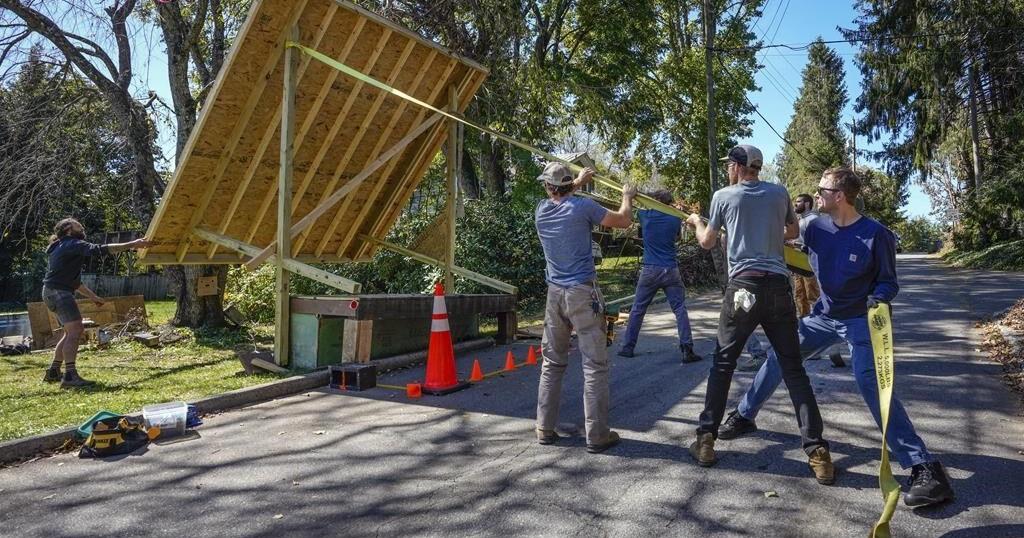BERGENFIELD, N.J. (AP) — At Sunshine Adult Day Center, every morning starts with a parade around the room.
Today, the theme is multicultural, and the flag bearers have no shortage of countries: Philippines, India, Haiti, Mexico, United States. Most of them older adults, attendees dance through the room, waving streamers and banging drums as Pitbull’s “I Know You Want Me” blasts.
Proudly representing her home country of Nigeria, Charity Wogwugwu, 87, is dressed to the nines in a pistachio green skirt embroidered with red and gold flowers, a lemon yellow floral top with puffed sleeves and a pleated gold headwrap.
“They pay attention to us. They recognize us,” said Wogwugwu, who lives in neighboring Teaneck with her daughter and six grandkids. “I love coming to Sunshine.”
Everyone at the center has a health need, be it mobility issues, dementia or difficulty completing daily tasks on their own. Sunshine staff say they have one goal: keep people mentally and physically sharp enough that they can stay out of places like nursing homes for as long as possible.
Adult day centers are the most racially diverse long-term care setting in the U.S., with many tailoring their offerings to the foods, traditions and cultures of their clientele and serving as key resource hubs to older people of color and immigrants. Day centers also serve the least amount of people of all long-term care settings, in part because of the cost and limited insurance coverage options; federal Medicare, the largest insurer of older adults, doesn’t cover them.
Sixty percent of people who use adult day centers identify as people of color, according to U.S. Centers for Disease Control and Prevention data. Centers like Sunshine are microcosms of their communities, attracting people from families who are especially reluctant to put their elders in residential long-term care due to cultural norms or their experiences with racism.
Overall, they’re “underrecognized” for the role they play in communities of color, said Tina Sadarangani, an adult and geriatric nurse practitioner who researches the aging of older immigrants at New York University.
“The biggest problem that adult day services contends with is public perception,” she said of the centers, which are sometimes seen as an equivalent to child “day cares.”
Battling isolation
On the other side of the country, He Fengling wakes up at 5:30 a.m. on days she goes to Hong Fook Adult Day Health Care Center near Oakland, California’s Chinatown district. It serves people of Chinese, Korean and Vietnamese backgrounds.
A day-center bus drops her off at about 8:30 a.m. She settles into her routine of a breakfast of toast and jam with a glass of milk, and reading the Sing Tao Daily, a Hong Kong newspaper. Then it’s time for physical therapy to relieve her arthritis and sciatica.
There are different pre-lunch activities each day. Today it’s table games: mahjong, tien gow, and Chinese chess, plus bingo. An automated voice says the bingo numbers in English, and a staff member follows with a translation.
“Everybody who sees me raises their thumb to tell me how great I’m doing, that I insist on coming,” said He, who is in her late 80s.
Corinne Jan, CEO of Family Bridges Inc., the nonprofit that runs Hong Fook, said they serve their clients in ways that other places can’t. She said the center’s focus is on the familiar — food, language and faces.
“I think all of our participants are monolingual, so they don’t speak English,” Jan said. “Imagine having to be in a nursing home or even just five days in a hospital or in the emergency room and not being able to communicate.”
Many older adults can feel isolated even among family as they age out of a caregiving role and into needing care themselves, experts said.
He came to the U.S. in the late 1990s to help her daughter with a new baby. Now, the same grandson that she helped raise checks on her and brings her to doctor’s appointments.
She has memory issues and reduced mobility, which has sometimes isolated her from simple interactions in her day-to-day life, like going to the store.
“After coming here … my thoughts are much more cheerful,” she said of the day center.
Older immigrants who might lack transportation, education, income and face language barriers can become “marginalized and sidelined in their own household,” Sadarangani said – even if they live with family. Adult day centers create a “kinship network” for them, she said.
And socialization can hold off depression, motivate people to stay active and even ease symptoms of dementia.
Sadarangani’s grandmother went to Sunshine in New Jersey before the pandemic. Her family’s experience inspired her to study the centers. She recalled the center giving her grandmother new experiences, including a tour of New York City in Hindi.
Serving families and communities
Advocates argue day centers are the most cost-effective long-term care. About 80% of people who attend day centers pay for it with Medicaid, which means the centers inherently serve a population that is not just more diverse but one that is almost entirely low-income.
The centers also are one-stop shops for communities of color to connect to resources that are otherwise hard to find and navigate.
Sunshine’s director of social work, Evan Heidt, spends each day talking with clients who are running out of food or have lost their housing. He wades through their Medicaid renewals and schedules surgeries and doctor’s appointments. Meanwhile, clients visit the in-house physical therapist to work on their mobility by pedaling a stationary bike, tossing balls and pulling exercise bands. Staff nurses check vitals, take blood sugar readings and administer medications daily.
Many adult day center clients report eating one meal per day – the one the center gives them, Sadarangani said. Heidt estimated some 20% of Sunshine’s clients have been homeless.
“We are the epicenter of the community, really,” Heidt said. “Not just the clients, but the families come to us, too.”
“Anybody have any problem, they solve it,” said Avtar Khullar, who attends Sunshine with his wife, Avinash. He came to the U.S. from New Delhi in 2007, and his aging parents attended Sunshine before they died.
But little is streamlined when serving such a diverse population. For breakfast alone, Sunshine’s small kitchen staff whips out 120 meals with 10 different options, including vegetarian, American, Filipino, Indian, kidney-friendly and fasting-friendly (fruits and nuts).
Grant funding is key for day centers, too, especially to bus clients there and home. Centers sent people care packages, activity books and meals during the pandemic even though they didn’t have enough money for it, said Lauren Parker, a gerontologist at Johns Hopkins University.
“A lot of programs actually ended up closing,” Parker said.
Sunshine has plenty of open spots, especially in its afternoon program. Many people didn’t come back after pandemic lockdowns were lifted.
Those who did say the center is a critical part of their routine and social life. That includes Theomene Valentine, 84, one of several Haitians who Sunshine buses in from Newark, an hour ride each way.
“I come here to talk in Creole with my friends,” she said.
Leticia Borromeo, 82, loved Sunshine so much she recruited her friends to attend with her. She is Filipino, and loves how the center exposes her to different cultures, foods and religions.
“We are like one family,” she said.
___
Associated Press journalist Haven Daley in Oakland, California, contributed to this report.
___
The Associated Press Health and Science Department receives support from the Robert Wood Johnson Foundation. The AP is solely responsible for all content.























